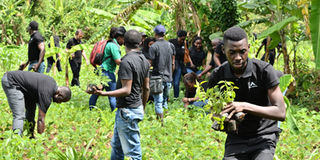ATC leads tree planting in Nakaseke

Staff of ATC Uganda during the tree-planting exercise in Nakaseke District. Below is Dorothy Ssemanda, the chief executive of ATC Uganda. photoS/GEORGE KATONGOLE
What you need to know:
- Technology company ATC Uganda is investing millions of shillings into saving Uganda’s forests as climate advocates warn that this latest effort is crucial.
Last week, more than 1,000 trees were planted at Kiteredde village in Ssakabusolo, Nakaseke District, in an ambitious plan to halt deforestation in the area facing pressure for more agricultural land and charcoal fuel.
Technology company American Tower Corporation (ATC) Uganda, who have embarked on the project of using available resources to avert the negative effects of climatic change, say they will stop at nothing in investing in the greening campaign.
“We have invested significantly in reducing the carbon emissions We are adding our voice to many entities who care and are concerned about this threat for which we are all accountable to the future generations,” says Dorothy Ssemanda, the CEO ATC Uganda.
Ssemanda was leading about 30 members of staff to plant trees in a move aimed at environmental sustainability.
Ssemanda says they collaborated with the Private Sector under the Running Out of Trees (Roots) campaign spearheaded by the Ministry of Water and Environment in partnership with Tree Adoption Uganda. The campaign aims at engaging local stakeholders in attaining National Restoration Goals of restoring more than 2.5 million hectares of degraded forest landscape by 2030.
Tree Adoption Uganda chooses where trees will be planted after signing a memorandum with land owners to keep the trees for at least 15 years.
Since 2021, ATC Uganda has participated in the Roots campaign by planting trees and donating towards the purchase of tree seedlings. The target will be reviewed in 2024.
“So far we have planted 7,000 trees where quarterly we come out with all our staff and put these trees in the ground,” Ssemanda says. Other trees were earlier planted at Bethany Land Institute in Nandere Parish, Luweero District.
Using technology, the trees are mapped to make sure they are growing.
The application which is available on Google Play is used to monitor sixty tree species on the platform from planting partners partly as a form of accountability.
Currently, the platform is used to monitor about 300,000 trees most of them across 15 districts in northern Uganda.
Important
“Planting trees is the best thing we could ever do,” says Angella Kansemire, the Project Officer Tree Adoption Uganda.
Kansemire says Uganda is grappling with climate change so tree planting endeavours aimed at combating deforestation are welcome.
Tree Adoption Uganda partners companies and civil society organisations to contribute to the cause by buying tree seedlings.
Kansemire says they want to achieve the agro-forestry model.
“The trees we chose are able to make the soil better and help the crops grow,” Kansemire said.
They have planted Grevillea Robusta, musizi and Terminalia elliptica.
“We are trying to re-green Uganda because the rate of forest loss cover is alarming. Pertinent to our organisation we are trying to plant indigenous trees,” she said.
According to National Forestry Authority (NFA), about 90 percent of Ugandans use firewood and charcoal for cooking resulting in intensified deforestation. The high demand for timber and charcoal has drastically reduced Uganda’s forest cover leading to calamities such as climate change, soil degradation, and loss of biodiversity.
Nakaseke is an important area for tree replanting because part of the area is for farming while the other is for cattle herders. All these activities have led to significant forest clearing.
Tree Adoption has since 2017 used smallholder farmers with more than five acres to give their land for tree planting. They have so far recruited 89 farmers in Nakaseke.
Her concern is survival rates which she says are as low as 40 percent. She attributes this to some farmers who do not care enough while some trees are funsuitable for the area. She says that neem tree, for instance, does not work properly in Nakaseke.
To take part in the greening campaigns one must provide proof of land ownership before signing a memorandum.
“We enlighten them on the role of trees in stopping soil erosion while improving the quality of the soil,” she says. But addressing the problem in one place often is not enough.
Kansemire notes that when some section of the population is enlightened, culprits shift to places with lower enforcement.




